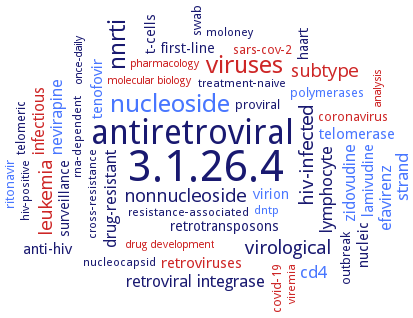3.1.26.4: ribonuclease H
This is an abbreviated version!
For detailed information about ribonuclease H, go to the full flat file.

Word Map on EC 3.1.26.4 
-
3.1.26.4
-
antiretroviral
-
nucleoside
-
viruses
-
nnrti
-
virological
-
hiv-infected
-
nonnucleoside
-
leukemia
-
subtype
-
integrase
-
lymphocyte
-
strand
-
cd4
-
efavirenz
-
retroviral
-
zidovudine
-
drug-resistant
-
infectious
-
nevirapine
-
retroviruses
-
telomerase
-
nucleic
-
tenofovir
-
lamivudine
-
anti-hiv
-
first-line
-
virion
-
t-cells
-
surveillance
-
retrotransposons
-
haart
-
polymerases
-
proviral
-
swab
-
covid-19
-
coronavirus
-
ritonavir
-
sars-cov-2
-
outbreak
-
telomeric
-
nucleocapsid
-
rna-dependent
-
resistance-associated
-
dntp
-
treatment-naive
-
hiv-positive
-
moloney
-
viremia
-
cross-resistance
-
pharmacology
-
drug development
-
analysis
-
once-daily
-
molecular biology
- 3.1.26.4
-
antiretroviral
- nucleoside
- viruses
-
nnrti
-
virological
-
hiv-infected
-
nonnucleoside
- leukemia
- subtype
-
integrase
- lymphocyte
- strand
- cd4
- efavirenz
-
retroviral
- zidovudine
-
drug-resistant
- infectious
- nevirapine
- retroviruses
- telomerase
- nucleic
- tenofovir
- lamivudine
-
anti-hiv
-
first-line
- virion
- t-cells
-
surveillance
-
retrotransposons
-
haart
- polymerases
-
proviral
-
swab
- covid-19
- coronavirus
- ritonavir
- sars-cov-2
-
outbreak
-
telomeric
-
nucleocapsid
-
rna-dependent
-
resistance-associated
- dntp
-
treatment-naive
-
hiv-positive
-
moloney
- viremia
-
cross-resistance
- pharmacology
- drug development
- analysis
-
once-daily
- molecular biology
Reaction
Endonucleolytic cleavage to a 5'-phosphomonoester =
Synonyms
Ape-RNase HII, aRNase HII, Bh ribonuclease H, BhRNase H, CtepRNH, EcRNH, endoribonuclease H, endoribonuclease H (calf thymus), ERNH, huRNaseH1, hybrid nuclease, hybrid ribonuclease, hybridase, hybridase (ribonuclease H), KOD1, LC9-RNase H1, lmo1273, LRNase HII, More, nuclease, hybrid ribo-, nuclease, ribo-, H, P32, protein ST0753, reverse transcriptase, ribonuclease H, ribonuclease H I, ribonuclease H(42), ribonuclease H(70), ribonuclease H1, ribonuclease H2, ribonuclease H3, ribonuclease HI, ribonuclease HII, ribonuclease HIII, ribonulease H1, RNA*DNA hybrid ribonucleotidohydrolase, RNA*DNA hybrid ribonucleotiohydrolase, RNase H, RNase H type 2, RNase H(35), RNase H1, RNase H2, RNase H3, RNase HI, RNase HII, RNase HIII, RNaseH, Rnaseh1, RNASEH2A, RNH, RNH1, RNH2, rnhA, RnhB, rnhC, rnhD, Rv2228c, ST0519, STK_07530, Sto-RNase HI, T4 RNase H, Tk-RNase HII, Tk-Tk-RNase HII, TK0805, TRNH, TthRNH, Ty1 reverse transcriptase/RNase H, type 1 ribonuclease H, type 1 RNase H, type 2 ribonuclease H, type 2 RNase H, type II ribonuclease H


 results (
results ( results (
results ( top
top





